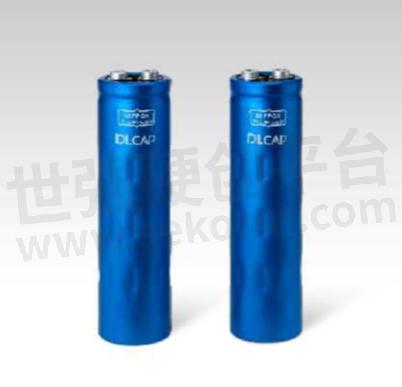Nippon Chemi-Con to Supply Electric Double Layer Capacitors DLCAP™ for Passenger Vehicles
Nippon Chemi-Con Corporation would supply Electric Double Layer Capacitors(EDLC), the DLCAP™ to Mazda Motor Corporation from 2012. The DLCAP™ would be used as part of Mazda vehicle’sregenerative braking system.
An announcement was made by Mazda in October 2010 about the next-generation SKYACTIV technologies, which significantly improve fuel efficiency and environmental performance by enhancing the basic performance of engines, transmissions, vehicle bodies, and chassis. The Demio, which went on sale this June, is receiving attention as the new-style, non-hybrid eco-friendly vehicle that offers fuel economy of 30.0km/L (10-15 mode).
For Mazda's vehicle in 2012, regenerative braking systems would begin to appear for additional fuel efficiency improvement. This regenerative system would use EDLC as its storage device for the first time in a passenger vehicle.
The system captures regenerative braking energy when the vehicle decelerates and stores it in the EDLC then uses the stored energy to power headlights, audio, navigation systems, and other electrical components. This would reduce alternator load and improve fuel economy by approximately 10 percent in real-world driving conditions with frequent acceleration and braking.
The DLCAP™ series selected for Mazda's regenerative braking system has been specifically developed for use in vehicles. Its internal resistance has been significantly reduced, while environmental durability (vibration and shock immunity, heat resistance) has also been improved. The main features of the series are as follows.
(1) Features ultra-low internal resistance
A large current charge is frequently repeated in regenerative braking systems each time the vehicle decelerates. Under this condition, using EDLC with high internal resistance often leads to the suspension of the system's function due to the self-heating of EDLC.
The DLCAP™ series, developed specifically for regenerative braking applications, features one-third of the internal resistance compared to the previous series of the same size.
With lower resistance, the series also has enhanced high current charge/discharge capability.
(2) Features superior heat resistance
Conventional EDLC is able to perform under temperatures below +60 degrees Celsius. For the aim to use EDLC safely in more severe conditions, Nippon Chemi-Con developed EDLC with an extended temperature range up to +70 degrees Celsius in 2009.
The DLCAP™ series developed this time also guarantees +70 degrees Celsius as its maximum temperature. As a result, it can be mounted in the engine room, and its tolerance toward self-heating caused by frequent regenerative braking has been improved.
(3) Comprises Non-acetonitrile electrolyte
Acetonitrile is one of the chemical compounds used in some companies' EDLC's electrolyte. It is said to be more beneficial to lower internal resistance than other electrolyte chemicals, however, it may generate extremely hazardous gases in case of combustion.
From the point of safety-first, Nippon Chemi-Con has always been developing the EDLC that does not comprise acetonitrile in its electrolyte. Using highly safe propylene carbonate, DLCAP™ features low resistance, quite comparable to the other EDLC using acetonitrile.
(4) Features high durability and superior vibration resistance
The DLCAP™ series achieves superior charge/discharge cycle characteristics; in other words, long life, based on Nippon Chemi-Con's years of research and development of reliability improvement technologies. It will therefore require no periodic replacement. With its rigid aluminum case structure, the DLCAP™ series also features high durability.
With regard to vibration resistance, an element-fixing structure has been employed as a countermeasure for the vibration of the element inside the aluminum case.
(5) Uses environmentally-friendly materials
The major material used in EDLC is activated carbon. No hazardous heavy metal is used and assures high safety levels. The impact on the environment can therefore be reduced when eventually disposing of the EDLC.
Nippon Chemi-Con has applied for 20 patents regarding the development of the DLCAP™ series.
Business Deployment
Nippon Chemi-Con would start production of the DLCAP™ series in spring 2012 at Chemi-Con Yamagata Corporation (Nagai City, Yamagata Prefecture, Japan: 100% owned subsidiary of Nippon Chemi-Con) and would increase its production capacity gradually.
In 2013, Nippon Chemi-Con planned to increase the overall production capacity of DLCAP™ to 480 thousand cells per month, which is 2.6 times the current capacity, when including the capacity of the existing production base at Chemi-Con Yonezawa Corporation (Kawanishi-machi, Higashi-Okitama, Yamagata Prefecture, Japan: 100% owned subsidiary of Nippon Chemi-Con). A production line with a significantly improved automation rate would be introduced to Chemi-Con Yamagata as Nippon Chemi-Con's third-generation production facility.
EDLC modules would be assembled at Chemi-Con Nagaoka Corporation (Nagaoka City, Niigata Prefecture, Japan: 100% owned subsidiary of Nippon Chemi-Con). The company would keep pace with increasing production of DLCAP™.
Specifications of the DLCAP™ series meet the demands of regenerative braking applications used in automobiles, industrial machinery, and other transports, as well as high-power applications. It is expected that the series serve as a trigger to extend the market.
Product Appearance

- +1 Like
- Add to Favorites
Recommend
- Nippon Chemi-Con Increased Production of Low- Resistance Electric Double Layer Capacitors DLCAP™ for Passenger Vehicles
- Nippon Chemi-Con Developed Supercapacitor DLCAP™ Modules MDKA150S8R3PE6111A for Industrial Equipment Developed
- Nippon Chemi-Con Conductive Polymer Hybrid Aluminum Electrolytic Capacitors HXJ Series - New Sizes Developed
- NIPPON CHEMI-CON Signs an Authorized Distributor Agreement with Sekorm
- Nippon Chemi-Con Adds a Rated Voltage of 25Vdc to Expand PXG Series SMD Type Conductive Polymer Aluminum Solid Capacitors
- Nippon Chemi-Con and Asahi Carbon Collaborated on Developing Novel Conductive Carbon “NH Carbon™” for Lithium-Ion Batteries
- Nippon Chemi-Con Developed Camera Module NCM-20-W Series for Immediate Detection Devices After Vehicle Reversing Motion
- Nippon Chemi-Con Added PMA Series Resin-Molded Chip Type Conductive Polymer Aluminum Solid Capacitors With a Low Profile of 3.0mm
This document is provided by Sekorm Platform for VIP exclusive service. The copyright is owned by Sekorm. Without authorization, any medias, websites or individual are not allowed to reprint. When authorizing the reprint, the link of www.sekorm.com must be indicated.












































































































































































































































































































































































































































































































































































































































































































































































































































































































































